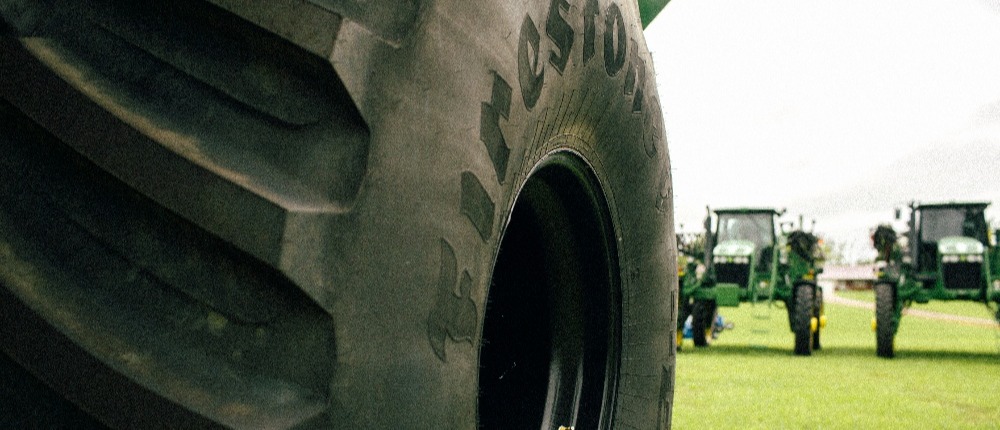The Importance of Changing Tire Pressure Based on Application
The Importance of Changing Tire Pressure Based on Application
Tire pressure can play a surprisingly important role in the life and cost of maintenance of your equipment and the efficiency and output. Ag tires can be costly to replace, but there are many ways farmers can extend the lifespan of tires while improving performance and increasing yields.
If the air pressure in your machine tires isn’t optimized, you could be missing out on significant benefits. And running on the wrong pressure could ruin the tire completely. Proper inflation depends on many factors and should be adjusted based on the application. Here are a few factors to consider when changing tire pressure.
Weight and Load
Optimal tire pressure is heavily influenced by the weight of the equipment and the load that it will carry. Inflation recommendations will vary greatly between a tractor with no add-ons and a loaded sprayer, so it’s essential to adjust tire pressure for each application.
You can use a grain or truck scale to weigh your equipment with attachments to get the maximum weight. To take it a step further, weigh each axle with the implement on it to ensure the weight distribution across each axle is balanced. This is referred to as ballasting, and the purpose is to keep the tractor balanced, which helps extend both tire and machine lifespan.
Once you know the weight of your equipment (including implements), you can use the tire manufacturer’s resources to determine optimal tire pressure. Recommended PSI information is in the equipment documentation, and many manufacturers have online calculators.
If your equipment is running too much weight on an underinflated tire, you’ll see a decrease in performance and faster wear and tear on the tire. And if you’re at full inflation with a smaller load, you’ll experience lower flotation, a smaller footprint, and increased compaction.
Type of Tire
Optimal inflation depends on the type of tire on the equipment. Using a higher-flexion (IF or VF) tire allows either an increase in weight or a decrease in tire pressure versus standard tires.
Lower tire pressure leads to more flexion in a tire. IF and VF tires have uniquely designed and manufactured sidewalls to allow them to withstand more flexion.
Driving Surface and Speed
Speed and weight produce friction—a tire’s greatest enemy. More weight, higher speeds, and harder surfaces all increase friction.
In a soft field where you’re moving 5-7 MPH, tires experience very little friction and heat production. Therefore, decreasing air pressure allows you to capture the benefits of farming on lower tire pressure.
However, when you’re on the road going 25 MPH on a hard surface, underinflated tires can be disastrous. Friction builds up heat, and heat destroys tires. VF and IF tires can withstand this friction better than standard tires but can still be destroyed by improper inflation.
In addition to surface type, terrain grade or slope is another ground condition to consider. If a field has hills and slopes, lower tire pressure can reduce traction and lead to slippage. Again, IF and VF tires help increase traction in many scenarios like this.
Adjusting Tire Pressure in the Field
There are so many considerations for tire pressure, and the benefits of adjusting tire pressure based on the application (i.e., in the field vs. roading; planting vs. spraying) can be significant. How do you confidently change tire pressure on the go?
Lowell Garrett, a successful Iowa farmer, recently had an onboard air inflation system installed on his John Deere DB120 Planter. With this system, he can easily adjust the air pressure from inside his tractor as he moves off and on the road. In the field, tire pressure can be decreased to maximize traction, increase the footprint, and minimize compaction. Before roading, the tire pressure can be increased to the highest recommended PSI to reduce friction, avoid heat build-up, and avoid wear and tear.
See how Garrett’s farm gained $100k in annual revenue.
Checking Tires for Wear and Tear
Ag tires must be checked often for any signs of damage, especially when the equipment was on the road. Tires should be inspected as regularly as possible and not just once per year or once per season. Checking for cracks, damage, and irregular wear can help identify an issue before it becomes a financial burden.
How to Determine the Correct Inflation Pressure of Your Tractor Tires
There are so many factors to consider when determining optimal tire pressure. And it’s not a set-it-and-forget-it decision. You can use resources on the tire manufacturer websites and talk to your dealer about tire and inflation options.
The experts at CFI Tire can also help you determine the proper tires and tire pressure optimization for your applications. We have decades of experience in the farming industry and can help you find the best way to increase your tires’ longevity.



